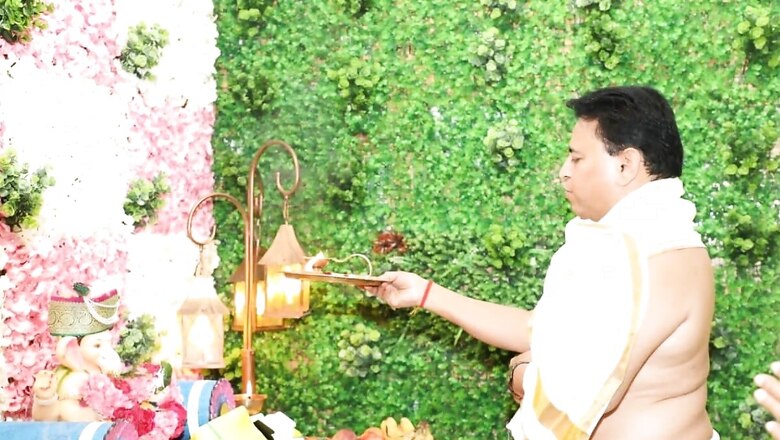Eunuchs Offering Aarti, Muslims Sporting Tilak: BJP Leader’s 'Sabka Saath' Ganpati Puja Draws Crowds

views
You may have seen many Ganpati pujas in your lifetime, but the one organised by BJP leader Sunil Deodhar — who is credited with bringing the party to power in Tripura in 2018 by ousting the 25-year Left rule — is something absolutely different.
While it may not have A-list celebrities and politicians like in Mumbai’s famous Lalbaugcha Raja pandal, Deodhar’s 10-day puja at his residence in Delhi’s North Avenue, which remains open to all, may have scaled heights in terms of setting a precedent for social messaging.
From sweepers to Muslims, eunuchs to the differently abled — everyone took part in this puja where the aim is said to be to bring the entire society together and turn it into a melting pot of assimilation.
On September 23, Deodhar invited eunuchs with tribal roots from Bihar to offer prayers. “Eunuchs are a section of society that has long been ignored and side-lined. I thought it would be fitting to invite them to my puja. What better way than this to celebrate BJP’s slogan of ‘Sabka Saath, Sabka Vikas’?” asked Deodhar.
Embracing diversity & inclusivity makes our society stronger.Invited the transgender community to my home for #SamarastaShriGanesh Puja.
Witnessing their participation in this celebration washeartwarming.
Let's spread #love, #Acceptance, #equality for all.#Ganeshotsav2023 pic.twitter.com/o9RzvWHQXz
— Sunil Deodhar (@Sunil_Deodhar) September 24, 2023
Reshma, a eunuch who attended the rituals, was emotional when she said: “Whenever we go to pandals, we are looked down upon. It is a matter of great pride for us to hold the thali of Aarti.”
That is not all. Deodhar also invited sweepers to conduct the puja instead of being just attendees. His logic was simple — social integration has to take place by walking the talk.
“Many have invited sweepers to offer puja before but to my knowledge, no one has allowed them to conduct the puja so far. Such barriers need to be broken,” Deodhar told News18. After conducting the puja, they distributed ghee-soaked ‘modaks’ amid a chant of ‘Ganpati Bappa Morya’.
While those practicing Islam who took part in the puja didn’t shy away from sporting ‘tilaks’ and offering ‘aarti’, the differently abled who joined in were ensured a ramp to smoothly operate their wheelchair right upto the Ganesha idol.
Ganesh Chaturthi celebrations, as we know today, have a history that connect it both to the freedom struggle and social integration. In 1893, Lokmanya Tilak praised the celebration of Sarvajanik Ganesh Utsav in Kesari — a daily run by him — and decided to escalate it to the level of an annual domestic festival. Tilak also recognised Ganesh’s appeal as “the god for everybody”.
According to Robert Brown, Tilak chose Ganesha as the god that bridged “the gap between Brahmins and non-Brahmins”, thereby building unity at the grassroots level to unitedly oppose British rule.
What Brown wrote in ‘Ganesh: Studies of an Asian God’ is that Lord Ganesha is seen to be an epitome of social integration and whose celebration can bridge differences. However, that sense has been waning over the years. “I have tried to do what it was actually meant to be,” says he.
While critics may say Deodhar’s puja will serve BJP well, given the inclusivity slogan raised by Prime Minister Narendra Modi, in a corner of Lutyens’ Delhi, the 10-day celebration of humanity and inclusivity will be remembered for years to come.

















Comments
0 comment